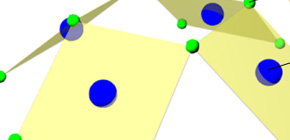
Detection of the magnetoelectric (ME) effect induced by magnetic quadrupolar moments, a world first
An international group of researchers led by Assistant Professor KIMURA Kenta and Professor KIMURA Tsuyoshi at the Graduate School of Engineering Science, Osaka University, together with researchers from The University of Tokyo, Swiss Federal Institute of Technology in Lausanne (EPFL), Paul Scherrer Institute, and Rutherford Appleton Laboratory, succeeded in verifying the magnetoelectric (ME) effect induced by a magnetic quadrupolar moments, or spin masses arranged in a quadrupole configuration, in copper oxide Ba(TiO)Cu 4 (PO 4 ) 4 , which has a square cupola cluster as a basic structural unit, a world first.
The ME effect allows an electric field to control the magnetic properties of a material and a magnetic field to control the electric properties, which has been drawing attention in the field of material science in recent years. The ME effect occurs only by the spin’s special spatial arrangement.
This group focused on the vortex-like spin arrangements, specifically, the magnetic quadrupole moments (electronic spins are arranged like the four bar magnets configured to produce a quadrupole as shown in Figure 2.) It was theoretically predicted that the quadrupole moments would exhibit the ME effect; however, matter showing such spin arrangements had not been discovered and was not experimentally verified.
In order to verify the possibility that the square cupola cluster might form quadrupole moments, this group synthesized clean samples of copper oxide Ba(TiO)Cu 4 (PO 4 ) 4 with Cu 4 O 12 square cupola clusters that consisted of copper ions (magnetic ions) and oxygen ligands, and closely examined their micro spin arrangement by using a neutron diffraction method. As a result, the group confirmed that the Cu 4 O 12 square cupola cluster exhibited quadrupole moments at a temperature of -264℃ or below.
Furthermore, this group performed dielectric measurements of these samples in a magnetic field and found that the dielectric property drastically changed by applying a magnetic field in the range of temperature at which the quadrupole moments were generated. From this, the presence of the ME effect due to the quadrupole moments was experimentally established, a world first.
It is expected that this group’s achievement will greatly facilitate the clarification of the ME effect based on the quadrupole moments and will lead to the development of novel electronic devices using the ME effect. This group’s results will serve as a useful guide for exploring and designing new ME-active materials based on vortex-like spin arrangements.
Abstract
In vortex-like spin arrangements, multiple spins can combine into emergent multipole moments. Such multipole moments have broken space-inversion and time-reversal symmetries, and can therefore exhibit linear magnetoelectric (ME) activity. Three types of such multipole moments are known: toroidal; monopole; and quadrupole moments. So far, however, the ME activity of these multipole moments has only been established experimentally for the toroidal moment. Here we propose a magnetic square cupola cluster, in which four corner-sharing square-coordinated metal-ligand fragments form a noncoplanar buckled structure, as a promising structural unit that carries an ME-active multipole moment. We substantiate this idea by observing clear magnetodielectric signals associated with an antiferroic ME-active magnetic quadrupole order in the real material Ba(TiO)Cu 4 (PO 4 ) 4 . The present result serves as a useful guide for exploring and designing new ME-active materials based on vortex-like spin arrangements.

Figure 1
Square cupola spin cluster consisting of four magnetic ions (blue) and twelve ligands (green)
Figure 2
Left: Quadrupole magnet configured by four bar magnets. Right: Quadrupole-type arrangement of four electron spins.

Figure 3
Spin arrangement of a Cu4O12 square cupola spin cluster determined by neutron diffraction measurements. The in-plane spin components form a quadrupole-type spin arrangement.

Figure 4
Temperature dependence of the dielectric constant in a magnetic field. The application of a magnetic field induces a sharp peak in the dielectric constant at the onset temperature of quadrupole-type spin arrangement.
To learn more about this research, please view the full research report entitled “ Magnetodielectric detection of magnetic quadrupole order in Ba(TiO)Cu 4 (PO 4 ) 4 with Cu 4 O 12 square cupolas ” at this page of the Nature Communications website.
Related link
